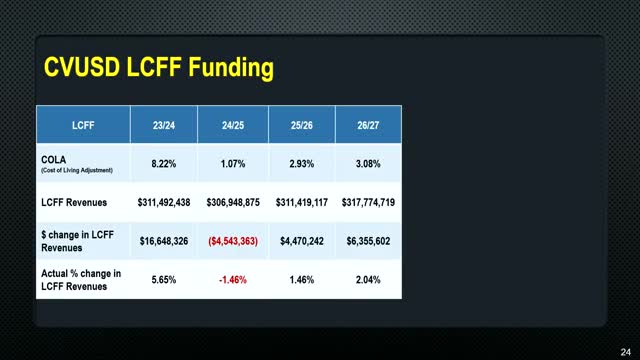District faces funding crisis amid declining enrollment
October 04, 2024 | Chino Valley Unified, School Districts, California
This article was created by AI summarizing key points discussed. AI makes mistakes, so for full details and context, please refer to the video of the full meeting. Please report any errors so we can fix them. Report an error »

In a recent government meeting, officials discussed the financial implications of declining enrollment and attendance rates on the district's funding. Despite a funded Cost of Living Adjustment (COLA) of 8.22 percent for the last fiscal year, the district only received $16.6 million in new funding, translating to a 5.65 percent increase. This discrepancy arose because the district's enrollment was down, and attendance hovered around 93 to 94 percent.
If the district had maintained the same enrollment and achieved perfect attendance, it would have qualified for the full 8.22 percent increase. The current year's COLA is projected at just 1.07 percent, which, when adjusted for the district's ongoing enrollment decline, results in a decrease of $4.5 million in total revenues compared to the previous year. This translates to a negative effective COLA of 1.46 percent for the district.
Looking ahead, projected COLAs for the next two years are 2.93 percent and 3.08 percent, respectively. However, officials cautioned that without a reversal in the trend of declining enrollment and improved attendance, the district is unlikely to benefit from these increases. The impact of COVID-19 on attendance rates has been particularly detrimental, further complicating the district's financial recovery.
If the district had maintained the same enrollment and achieved perfect attendance, it would have qualified for the full 8.22 percent increase. The current year's COLA is projected at just 1.07 percent, which, when adjusted for the district's ongoing enrollment decline, results in a decrease of $4.5 million in total revenues compared to the previous year. This translates to a negative effective COLA of 1.46 percent for the district.
Looking ahead, projected COLAs for the next two years are 2.93 percent and 3.08 percent, respectively. However, officials cautioned that without a reversal in the trend of declining enrollment and improved attendance, the district is unlikely to benefit from these increases. The impact of COVID-19 on attendance rates has been particularly detrimental, further complicating the district's financial recovery.
View full meeting
This article is based on a recent meeting—watch the full video and explore the complete transcript for deeper insights into the discussion.
View full meeting
